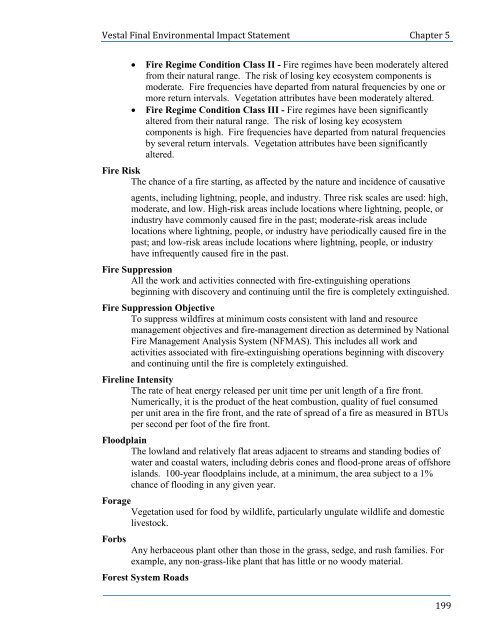Final Environmental Impact Statement
Final Environmental Impact Statement
Final Environmental Impact Statement
You also want an ePaper? Increase the reach of your titles
YUMPU automatically turns print PDFs into web optimized ePapers that Google loves.
Vestal <strong>Final</strong> <strong>Environmental</strong> <strong>Impact</strong> <strong>Statement</strong> Chapter 5<br />
• Fire Regime Condition Class II - Fire regimes have been moderately altered<br />
from their natural range. The risk of losing key ecosystem components is<br />
moderate. Fire frequencies have departed from natural frequencies by one or<br />
more return intervals. Vegetation attributes have been moderately altered.<br />
• Fire Regime Condition Class III - Fire regimes have been significantly<br />
altered from their natural range. The risk of losing key ecosystem<br />
components is high. Fire frequencies have departed from natural frequencies<br />
by several return intervals. Vegetation attributes have been significantly<br />
altered.<br />
Fire Risk<br />
The chance of a fire starting, as affected by the nature and incidence of causative<br />
agents, including lightning, people, and industry. Three risk scales are used: high,<br />
moderate, and low. High-risk areas include locations where lightning, people, or<br />
industry have commonly caused fire in the past; moderate-risk areas include<br />
locations where lightning, people, or industry have periodically caused fire in the<br />
past; and low-risk areas include locations where lightning, people, or industry<br />
have infrequently caused fire in the past.<br />
Fire Suppression<br />
All the work and activities connected with fire-extinguishing operations<br />
beginning with discovery and continuing until the fire is completely extinguished.<br />
Fire Suppression Objective<br />
To suppress wildfires at minimum costs consistent with land and resource<br />
management objectives and fire-management direction as determined by National<br />
Fire Management Analysis System (NFMAS). This includes all work and<br />
activities associated with fire-extinguishing operations beginning with discovery<br />
and continuing until the fire is completely extinguished.<br />
Fireline Intensity<br />
The rate of heat energy released per unit time per unit length of a fire front.<br />
Numerically, it is the product of the heat combustion, quality of fuel consumed<br />
per unit area in the fire front, and the rate of spread of a fire as measured in BTUs<br />
per second per foot of the fire front.<br />
Floodplain<br />
The lowland and relatively flat areas adjacent to streams and standing bodies of<br />
water and coastal waters, including debris cones and flood-prone areas of offshore<br />
islands. 100-year floodplains include, at a minimum, the area subject to a 1%<br />
chance of flooding in any given year.<br />
Forage<br />
Vegetation used for food by wildlife, particularly ungulate wildlife and domestic<br />
livestock.<br />
Forbs<br />
Any herbaceous plant other than those in the grass, sedge, and rush families. For<br />
example, any non-grass-like plant that has little or no woody material.<br />
Forest System Roads<br />
199

















